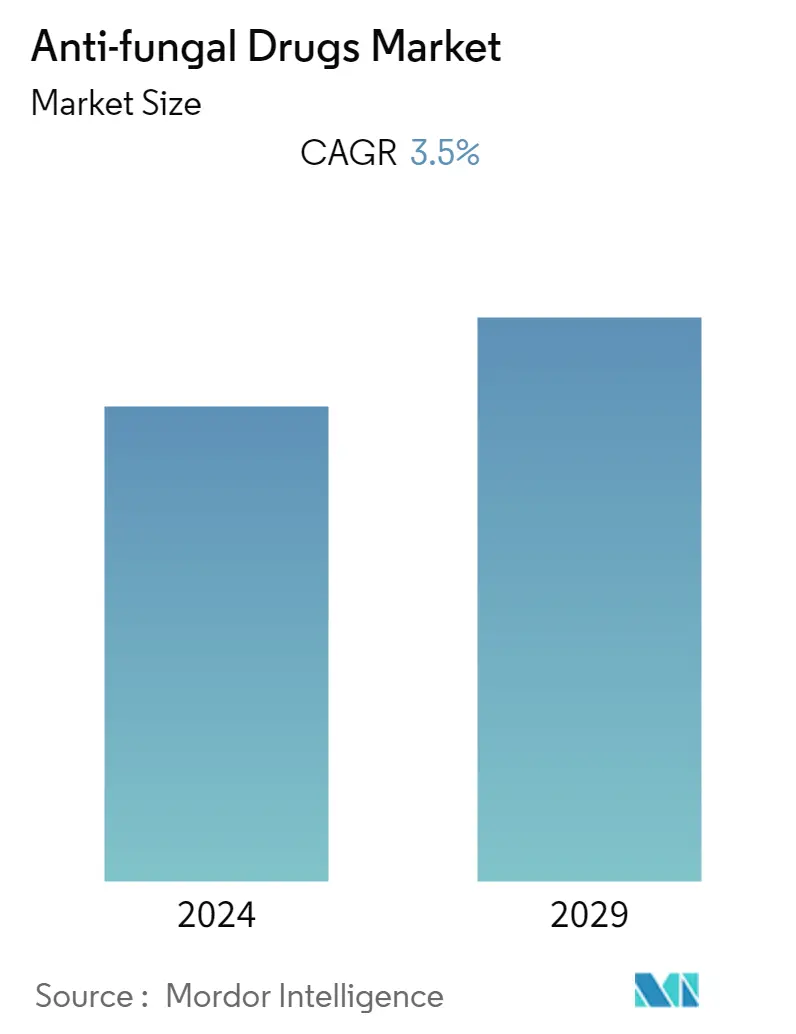Market Size of Anti-fungal Drugs Industry

| Study Period | 2020 - 2029 |
| Base Year For Estimation | 2023 |
| CAGR | 3.50 % |
| Fastest Growing Market | Asia Pacific |
| Largest Market | North America |
| Market Concentration | Low |
Major Players
*Disclaimer: Major Players sorted in no particular order |
Need a report that reflects how COVID-19 has impacted this market and its growth?
Anti-Fungal Drugs Market Analysis
The anti-fungal drugs market is expected to register a CAGR of 3.5% during the forecast period.
- The anti-fungal drug market is expected to experience significant growth and register a CAGR of 3.5% during the forecast period. The COVID-19 pandemic profoundly affected the market, with import and export operations being limited due to closures, resulting in shortages and unavailability of consumer goods and supplies. However, emerging reports and research indicated that a significant number of patients with severe COVID-19 infections required intensive care and were fighting another fatal infection, such as aspergillosis, caused by Aspergillus fungus.
- According to a study published in the Journal of Microbiology, Immunology, and Infection in February 2021, invasive pulmonary aspergillosis (IPA) incidence ranged from 19.6% to 33.3% among the studied population. Thus, researchers have found that patients with COVID-19 were at greater risk of pulmonary infections caused by fungal respiration, creating a demand for anti-fungal drugs during the later phases of the pandemic. Consequently, despite the short-term decline in the number of drugs and supply chain disruptions, the increasing fungal infections among COVID-19 patients had a considerable impact on the market, which is expected to continue to gain traction during the analysis period.
- The major factors contributing to the growth of the anti-fungal drug market include increased awareness of many fungal infections, rising numbers of over-the-counter (OTC) anti-fungal drugs, and increased use of antimicrobial drugs in developing countries. The growing popularity of OTC drugs such as clotrimazole, econazole, ketoconazole, miconazole, and amorolfine has resulted in many patients using OTC drugs. An increase in onychomycosis cases, a fungal infection of the fingers and toes, is also expected to contribute to the market growth. For instance, according to the data updated by CDC in September 2022, onychomycosis may affect up to 14% of the general population in the world, and fungal toenail infections are more common than fungal fingernail infections.
- Moreover, excessive glucose can lead to high cellular damage, resulting in several infectious and non-infectious skin disorders. Therefore, diabetes patients are more susceptible to various fungal infections, and onychomycosis is one of the major infections among the target population. According to an article published in the Journal of Fungi in August 2022, when a group of people was studied for skin and nail disorders in diabetic patients, onychomycoses were found common in critically ill diabetic patients.
- Dermatophytes were found to be the commonest cultural isolates (50%), followed by yeasts and molds in 30.8% and 19.2%, respectively, of the studied diabetes patients. Hence, the high burden of diseases among the target population is expected to increase the demand for anti-fungal and contribute to the overall growth of the studied market over the forecast period.
- However, increasing resistance to anti-fungal drugs and the side effects of these drugs are anticipated to hinder their adoption and demand, thereby restraining the market's growth.

